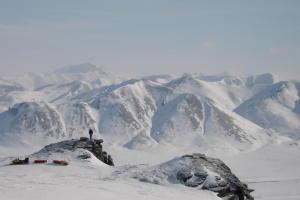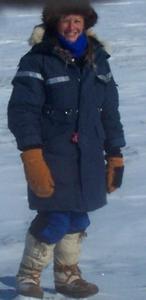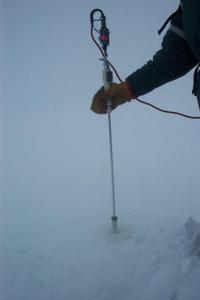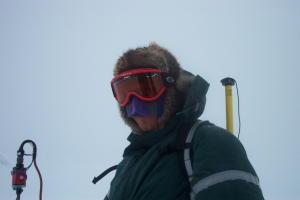11 April, 2002
Let's do some sample GPS/MagnaProbe measurement
analysis. If the following depths were recorded
on a long walk (these are actual numbers from one of our MagnaProbe lines),
how does the terrain appear?
Find the average of the following snow depths for each of the
terrain/vegetation types.
Make a bar graph comparing the snow depths.
Question:
What relationship do you see between the vegetation type and snow depth?
Terrain_Type Depth (centimeters)
short shrubs 71.406
short shrubs 37.034
short shrubs 60.334
short shrubs 61.054
short shrubs 69.899
stream channel 57.514
stream channel 65.520
stream channel 93.198
stream channel 95.147
stream channel 75.677
tall shrubs 84.644
tall shrubs 90.221
tall shrubs 99.636
tall shrubs 91.238
tall shrubs 80.984
tundra 16.999
tundra 22.725
tundra 18.978
tundra 17.539
tundra 19.338
trees 111.48
trees 118.22
trees 103.14
trees 115.97
trees 121.34
WHERE IS MRS. CHEUVRONT??? LET'S PLOT!!!
LATITUDE: 68.48202 degrees North
LONGITUDE: 155.75247 degrees West
The temperature has dropped. The mountains have proved that they lie
within the Arctic. Morning was cold and brisk. Frost formed on my braids
along with my eyelashes. A cold job lay ahead for Glen and I. We would
perform a Class 1 Chemical sample in the middle of the Brooks Range
Mountains. The remote placement of the sampling site is essential to
determine if Arctic haze chemical components are being deposited in the
snow. I wore my heaviest parka, my hat, and gave up my warm mittens for
two layers of cold latex gloves. The tyvek suit was cumbersome putting on
over the layers of clothes. The wind was gracious to us and quieted while
we performed the four-hour meticulous job. Our work was finished and it
was time to travel out of the Brooks Range. The mountains lead us on a
path, a portal out of the mountains. The portal was aligned with steep
rocks and sculpted snow. The mountains had granted us a safe journey; they
allowed us to bear witness to their beauty. The mountains could be a place
of ferocious winds and cold air. We had been blessed with good weather and
safe traveling. We traveled out of the mountains and the North slope lay
ahead. At the base of the Brooks Range lies a sacred place called the Mesa
Site. The Mesa Site sits as a large rock which holds ancient secrets.
Archaelogists have found remains from humans dating back to 13,000 years
ago. One could imagine a time long ago where humans sat on the rock and
looked for mastodons and bisons to be hunted for food. The climate and
life was different in the Arctic at that time. Our life on our journey was
about to change; Ivotuk would be our safe haven for the evening.
Temperature Min -29 degrees Celsius (about -20 degrees F)
Temperature max: -19 degrees Celsius
Matthew Sturm
USA-CRREL-Alaska
P.O. Box 35170
Ft. Wainwright, AK 99703
907-353-5183
msturm@crrel.usace.army.mil

The Brooks Range Mountains.

A day of Science in the Arctic.

The MagnaProbe. The basket at the end stops at the top of the snowpack.

Ken running the MagnaProbe/GPS unit. The yellow rod out of the back is the attenna for the satellites.
Contact the TEA in the field at
.
If you cannot connect through your browser, copy the
TEA's e-mail address in the "To:" line of
your favorite e-mail package.
|
